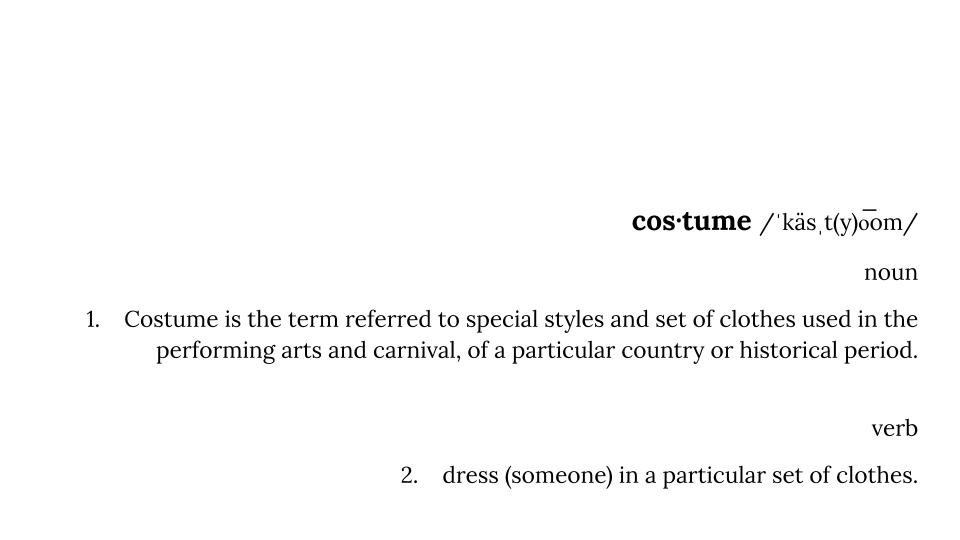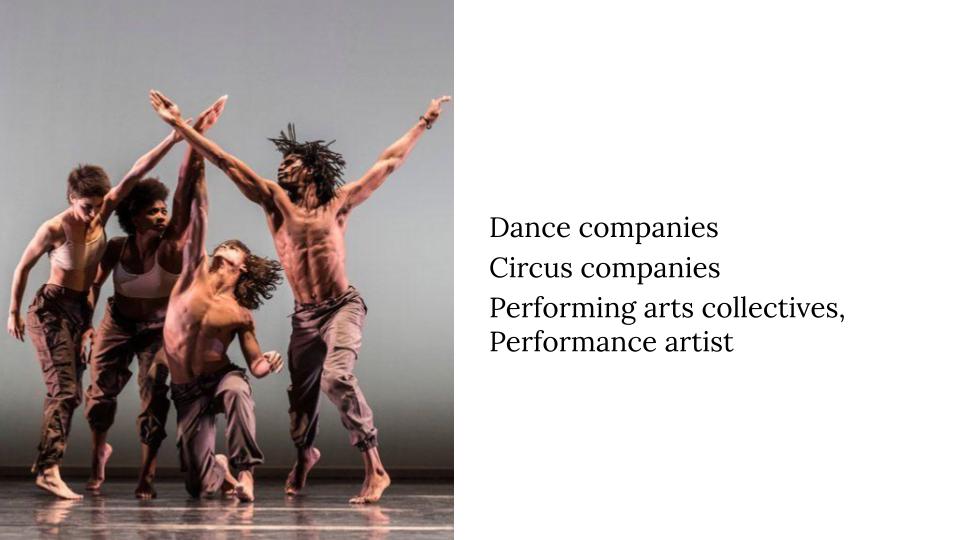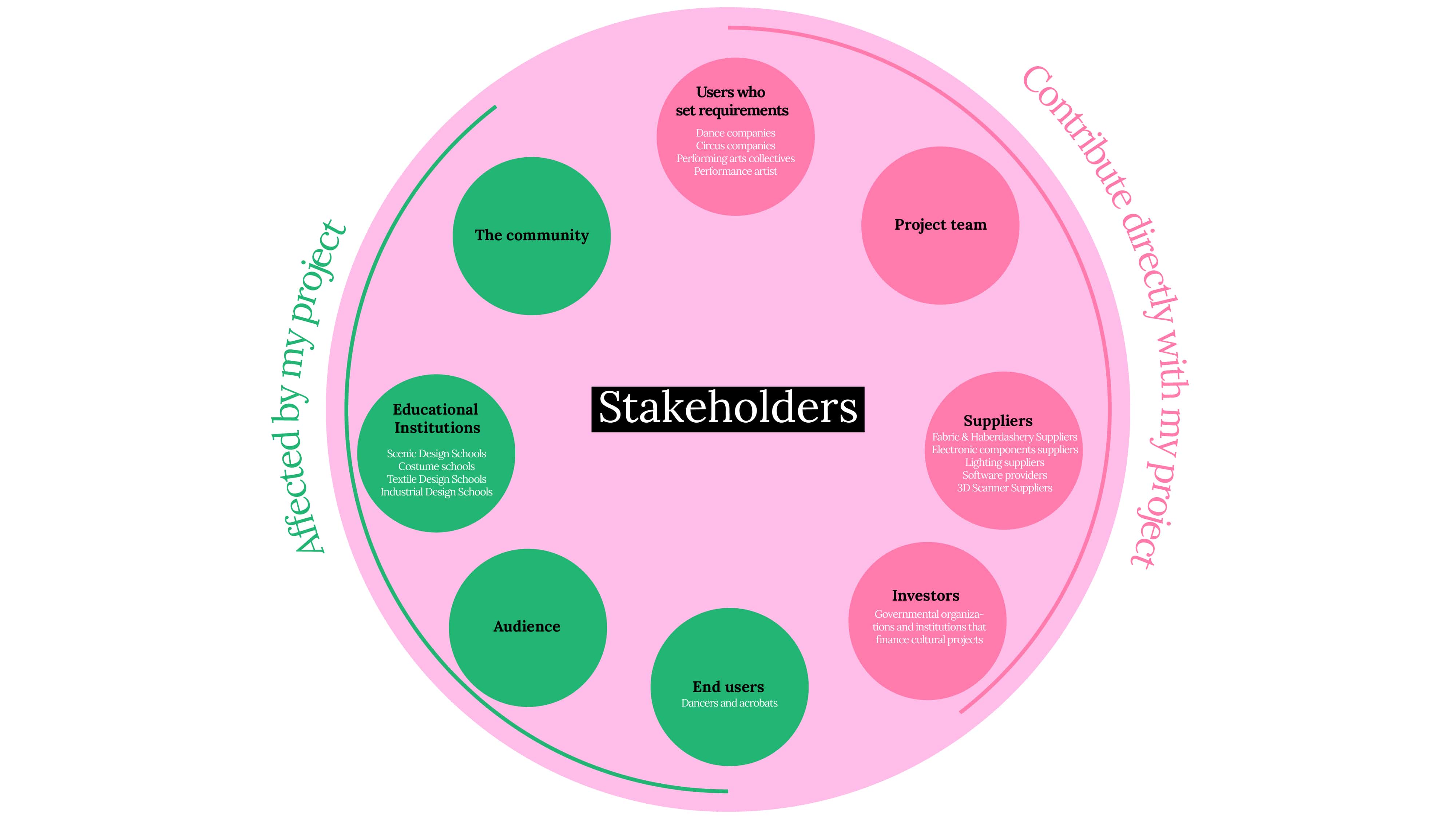11. Implications and applications¶
Final project proposal presentation¶
Movimiento Inefable¶
How to use technology to amplify the movements of the human body: designing an interactive costume¶

The objective of this project is to develop interactive costume pieces that amplify the movements of the human body. The project aims to design a wearable applied to the scene, which amplifies the potential of scenic expression of the human body in relation to movement and space.


“_Costumes reveal themselves as a tangible and critical nexus of human interaction in the making and in the experiencing of performance (…). As a material, performed-in object, costume renders ideas physical and embodies thoughts”
“From the material gestuality and the tactile communication of its stiches and folds, to the structural links that trace the wide-ranging contours of concepts (…), the journey of costume from the cutting table to the stage is reflected in the makings, wearings, and readings of it. In this, hands that make, limbs that wear, and eyes that watch implicate the body as its central shared core, as costume becomes an object in movement –from material into embodiment on stage- in the affective communication between performers and audience.”_ Costume in Performance
I intend to design and create a costume by studying the relationship between the space, the body and their movements. Costumes give meaning to movement, amplifying it, producing sphimeral spaces, which are constantly being assembled and disassembled.
I aim to investigate and study typologies and forms of garments and costumes that amplify the movements of the person wearing them (such as pleats, flounces, amplitude). Then incorporate a circuit that contains a sensor (of movement, speed, light) that collects information, which can be transformed into some kind of output, either in the costume itself, for example through light (with leds or fiber optic), or communicating with other elements that are usually part of the scenes, for example lighting, or visual projection.



- As a way to merge, materialize and apply all the transdisciplinary knowledge and tools seen in Fabricademy
- To take advantage of the new possibilities that technology gives us to enhance the transformation capabilities of bodies through costumes.
- To connect the multiple disciplines that are brought together in the performing and scenic arts, especially costume, light and visual
- To use digital fabrication to offer a personalized costume design service, making customized solutions, for specific bodies and specific performance with innovative material, technologies and techniques.

I intend to work with people whose body is their main means of expression.

STAKEHOLDERS Stakeholder mapping involves identifying, analyzing and prioritizing the people and organizations with a stake in the project features and performance.
Contribute directly with my project
-
User who set requirements: Dance companies, circus companies, performing arts collectives, performance artist
-
Project team: I propose to work with a group of people specialized in different areas, such as programming, parametric design, e-textiles and wearables, performing arts
Affected by my project
-
Suppliers
- Fabric Suppliers
- Haberdashery Suppliers
- Electronic components suppliers
- Lighting suppliers
- Parametric design software providers
- 3D Scanner Suppliers
-
Investor: governmental organizations that finance cultural projects
- End users of project outputs: Dancers and acrobats
- The audience that attends to the performing and scenic arts
- Education Institutions: Scenic design schools, costume schools
- The community, from the sphere of people related to the performing arts, the visual arts in general, but also the multiple disciplines that can somehow benefit from this transdisciplinary knowledge



Research
- Background search: projects and works of artists and designers related to the subject.
- Search of bibliography related to the theme.
- Preliminary form research: start investigating different types of pattern and textile resources that amplify the movement.
- Preliminary research in e-textiles. Investigate what type of sensor can be used to capture movement, how to incorporate them into a textile circuit, what would be the input (changes in speed, position, amount of light) and what would be the output
Development, design and production
- Choose of a specific performing arts discipline to start working. For example, a dancer, an acrobat, an actor, a performance artist.
- 3d scan of the artist
- Costume design: start by working directly on the person's body, with specific 3d modeling software such as Rhinoceros and Grasshopper.
- Making prototypes with digital manufacturing
- Testing
- Correction and adjustment
- Realization of the final costume
Fabricademy modules used Digital Bodies: 3D scanning, motion capture E-textiles Computational Couture Wearables

Initially, I would like to develop this project in Uruguay
UPPSS¶
Personalization is “a means of meeting the customer's needs more effectively and efficiently, making interactions faster and easier and, consequently, increasing customer satisfaction and the likelihood of repeat visits,”
The proposal of my project is to present a personalized costume design service.
For that I propose to create generative designed and fit costumes, to addapt to the exact measures and forms of the bodies of the artists. By 3d scanning their bodies, and by designing using a parametric design, cosutmes can easly be adappted to meet the users needs effectively and efficiently. Not only dancers and artist needs, but also dramaturgic needs.
Feedback¶
Oscar Tomico comments
-
Work with the movement quality of the textile, enhancing existing textile techniques (like pleats) and amplify with digital fabrication, but not necessary e-textiles.
-
Keep in mind that electronic circuits and movement and dancing are not always friends. His recommendation was that I should be careful not to complicate myself too much by adding sensors and electronic components if it is not necessary
-
Investigate in motion tracking. Think of doing something invisible, a garment that does not have to be seen.
-
Data will become a material. If I’m going that path, I should choose a soon as possible which sensor to use.
Recommendations from my peers
-
Experiment with shape memory alloy- adding materials that move to garments intended for movement
-
Identify the performer and work together in a piece that can be created together with the concept of the performance
-
Computational and soft robotics can be used in my project
-
Exploring changing color who react to the everyday performance can be interesting, increasing the power of movement
Research¶
Light Sculpture
SpaceTime Helix from Michela Pelusio on Vimeo.
Interactive Patterns
Miguel CHEVALIER Magic Carpets 2014, Castel Del Monte, Italy (short version) from Claude Mossessian on Vimeo.
ENTE: interactive audiovisual installation
Real Time Tracking & Projection Mapping
Tracking Movement
Hidden Movement // The Making of a Motion Capture Project
References¶
Bibliography¶
- Barbieri, Donatella (2017) Costume in Performance. Materiality, Culture and the Body. London: Bloomsbury
- Saltzman, Andrea (2009) [2004]. El cuerpo diseñado: Sobre la forma en el proyecto de la vestimenta. Buenos Aires: Paidós.
- Deangelis, Sol (2014) Oskar Schlemmer, el Ballet Triádico y el vestuario en la Bauhaus
- Vernelle, Noel (2017). From Costuming and Dancing Sculptures to Architecture. The Corporeal and Computational in Design and Fabrication of Lightweight Mobile Structures
- Sampedro, Javier; Botana, Marta (2010). Dance, the Architecture of Movement